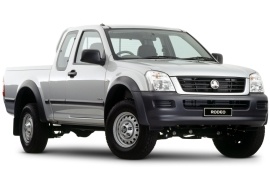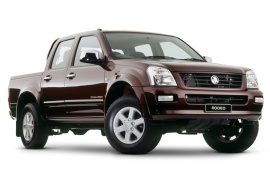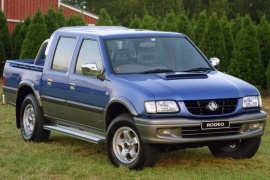HOLDEN Rodeo Models/Series Timeline, Specifications & Photos
First production year: 1996
Engines: Diesel, Gasoline
Body style: SUV (Sports Utility Vehicle)
Holden was one of the brands that benefited from Isuzu and General Motors' agreement, receiving the Rodeo lineup, which it introduced on the market in 2003.
Based on the Chevrolet's Colorado chassis, the Holden Rodeo was a re-badged Isuzu D-Max sold in Australia and New Zeeland in a few body shapes. It was the workhorse in the Space-Cab version and a family-friendly vehicle in the Double-Cab version.
Even if the car looked like the design team was the less-favored part in the project, it showed a rugged style, fit for the light pickup market. Its vertical headlights made room for a wider grille, needed mainly for the gasoline-powered versions. On the sides, the car sported an additional set of windows behind the doors, with a pop-out opening system. Holden offered the Space Cab either as a chassis-cab or as a complete vehicle with a bed that provided a maximum length of 2270 mm (83.3")
Inside, the materials used were not of the highest quality, but they were built to last. Its hard-plastic dashboard and soft padding on the door panels offered an adequate compromise for the vehicle's destination. The instrument cluster was carried over from Isuzu, with a large speedometer in the middle, flanked by a tachometer on the left and the fuel and temperature gauges on the right. On top of the center stack, the carmaker installed three buttons for the 4x4 traction system.
Unlike Isuzu, who offered the car mostly with diesel engines, and Chevrolet, who sold the Colorado with gasoline versions, Holden benefited from both versions. Power ranged between a 78 hp diesel unit and a 200 hp V-6 gasoline powerplant.
When GM and Isuzu joined forces to create vehicles together, they received something needed from the other partner, and Holden was one of the biggest winners.
With its high expertise in building light utility vehicles, the American team designed and produced the chassis for the Chevrolet Colorado, which GM also used on other vehicles built the American carmaker under different names, including the Hummer H3 SUV. On the other hand, Isuzu was the biggest diesel-engine builder in the world and put its 2.5-liter and 3.0-liter turbo-diesel units on the table. As a result, GM benefited from that arrangement and sold a re-badged Isuzu D-Max on the Australian market under the Holden Rodeo nameplate.
Even if the car looked like the design team was the less-favored part in the project, it showed a rugged style, fit for the light pickup market. Its vertical headlights made room for a wider grille, needed mostly for the gasoline-powered versions. In its Double Cab form, the Rodeo offered a cabin with four doors fit for five adults.
Inside, the materials used were not of the highest quality, but they were built to last. Its hard-plastic dashboard and soft padding on the door panels offered an adequate compromise for the vehicle's destination. The instrument cluster was carried over from Isuzu, with a large speedometer in the middle, flanked by a tachometer on the left and the fuel and temperature gauges on the right.
Unlike Isuzu, who offered the car mostly with diesel engines, and Chevrolet, who sold the Colorado with gasoline versions, Holden benefited from both versions. Power ranged between a 78 hp diesel unit and a 200 hp V-6 gasoline powerplant.
Pickups were in high demand in Australia, and GM tried to get a piece of the market when it worked together with Isuzu and created the Holden Rodeo Double-cab.
The cooperation between Isuzu and GM looked good for everyone, even though their badge-engineered products were rightful competitors in some parts of the world. In Australia, Holden was still a respected brand, and it sold in good numbers.
Its front fascia resembled the second generation of the Isuzu Trooper and the Holden Jackaroo, with its small rectangular headlights and the smiling grille shape. The bumper and the side moldings were offered in contrasting colors depending on the trim level and options. As an option, the carmaker offered a set of side steps. With its four-door configuration, the Rodeo Double-cab provided just enough room for five and a bed in the back that could carry enough stuff and tools for a day at work.
As with any rugged utility vehicle from those times, the interior was reduced to basic needs for the base trim level. It offered just a basic dashboard with six gauges plus the tachometer and speedometer wider. The front bucket seats were fine in terms of legroom and headroom, but there was limited room in the back for three adults. In the bed, the carmaker promised that the Holden Rodeo Double-cab could carry up to one ton.
Holden offered a wide choice of engines for the Australian pickup, either diesel or gasoline. The most potent version was not exactly a workhorse since the 3.2-liter V6 was far from being fuel-efficient. On the other hand, the turbodiesel versions were in high-demand thanks to their pulling power.


